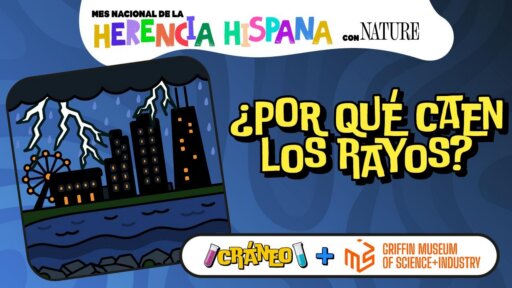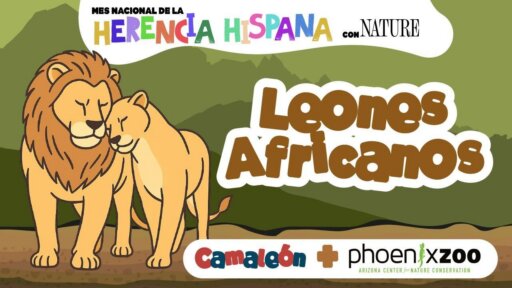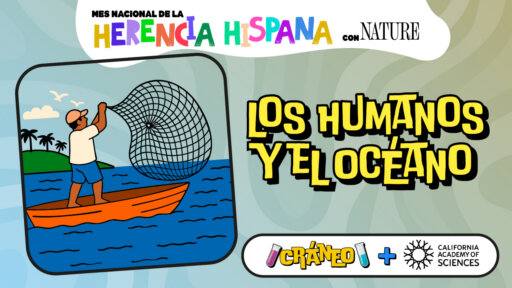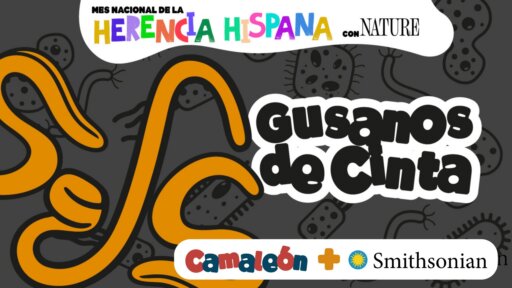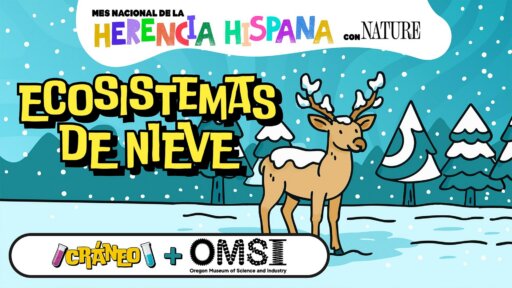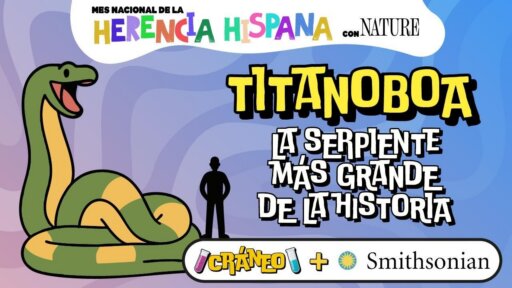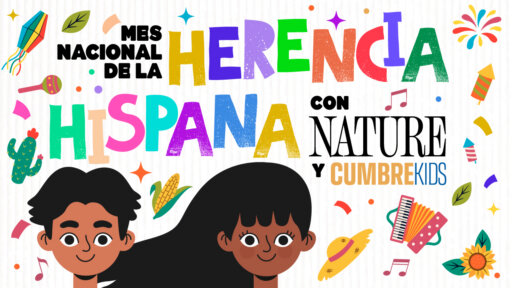TRANSCRIPT (EN)
00:00:01 Robert C:
Hi there, Rob here. This episode is part of a bilingual children’s podcast series for National Hispanic Heritage Month, a collaboration between PBS Nature and Cumbre Kids. This series features scientists from leading museums, zoos, and aquariums across the United States, responding to questions submitted by listening children 3 to 10 years old.
00:00:20 Robert:
These episodes appear on the podcasts Orbit: Science for Kids on the Move, Cráneo: Science for Curious Kids, and Camaleón: Animals for Curious Kids.
00:00:30 Robert:
They are podcasts for families with children 3 to 10 years old and can be found on YouTube, Spotify, Apple Podcasts, or wherever you listen to podcasts.
00:00:38 Robert:
Just a heads up, this episode is in Spanish.
00:00:41 Robert:
We hope you enjoy.
00:00:46 Wil:
Recently I walked along a trail in the savanna, and suddenly a very strong smell filled the air.
00:00:56 Wil:
I looked at the ground and saw something incredible.
00:00:59 Wil:
A beetle pushing a ball bigger than itself, but it wasn’t just any ball.
It was a poop ball.
I asked myself, why is that beetle carrying a poop ball?
And how did it make that poop ball?
And where is it taking it?
00:01:16 (Various children):
Why are dung beetles so attracted to poop?
How big are they?
How many years can they live?
00:01:24 Wil:
That’s right, chameleons.
Today we are in for an adventure where we will meet some tiny but amazing workers.
00:01:32 Wil:
The dung beetles!
We will discover how they turn other animals’ poop into something very valuable, how they find their way in the dark, and why they are so important to life in nature.
Ready to crouch down, take a close look, and explore the world of these fascinating little animals?
Here we go!
00:02:01 Wil:
Hello, hello, chameleon friends…
00:02:08 Isa:
How are you?
00:02:09 Wil:
How are we, how are we, Isa, how are you?
00:02:13 Isa:
Very well, Wil, and you?
And hello also to our mini listeners and their families who make this podcast possible.
00:02:21 Wil:
Yes, hello!
00:02:23 Wil:
What happiness there is today in this studio, Isa, we are very happy.
Well, I am very happy. How are you?
00:02:30 Isa:
Good, dancing, dancing, dancing.
00:02:32 Wil:
Uh-huh, today we are going to enjoy the music a lot, Isa, look.
00:02:38 Wil:
Over here Gerwuin left his instruments.
00:02:41 Isa:
Oh yes.
00:02:43 Wil:
Here, take this ukulele, he lends it to me.
00:02:48 Isa:
Hold it for me, please.
00:02:52 Wil:
And me, the Venezuelan cuatro.
00:03:01 Wil:
On the count of three, let’s sing an improvised song: 1, 2, 3, we are in Camaleón.
00:03:09 Isa:
We are in Camaleón.
00:03:13 Wil:
I don’t know how to play this.
00:03:14 Isa:
Come on, come on, let’s switch.
00:03:16 Wil:
We switch, now I have the cuatro and you have the ukulele.
00:03:21 Wil:
Okay.
00:03:22 Wil:
We are in Camaleón.
00:03:26 Isa:
We are in Camaleón.
00:03:31 Wil:
Isa, I think we are a disaster at playing instruments, right?
I think our talent lies elsewhere.
00:03:37 Isa:
Yes.
00:03:40 Wil:
Yes, better let’s put away Gerwuin’s instruments.
00:03:42 Isa:
So Gerwuin doesn’t find out.
00:03:45 Wil:
I’m going to tell him I borrowed them, he lends them to me.
Yes, yes, yes, because you have to tell him.
Very good, Isa, what a joy to be with you in a new episode.
How have you been? Tell me.
00:03:59 Isa:
I am a robot.
00:04:01 Wil:
Today you are a robot named “Isa 2.0.”
00:04:11 Wil:
We’re going to do a competition of…
00:04:13 Isa:
Well, a little game.
00:04:14 Wil:
What do you think if we do a laughter competition?
00:04:16 Isa:
Yes, first the most evil laugh.
00:04:19 Wil:
Let’s see who has the most evil laugh.
00:04:28 Wil:
Isa, they call you the…
00:04:31 Isa:
The villain of the classroom.
00:04:32 Wil:
The villain of the classroom, let’s hear how the villain of the classroom laughs.
00:04:35 Wil:
Now it’s my turn.
00:04:44 Isa:
You look like Frieza, you’re just as bald and everything.
00:04:47 Wil:
Really? Okay, on the count of three we’ll laugh evilly. 1, 2, 3.
00:04:55 Wil:
Wow! How much evil there is here in the studio!
00:05:01 Wil:
Now Isa, who will have the funniest laugh?
00:05:04 Isa:
You start.
00:05:14 Wil:
Now who has the funniest laugh, Isa? Let’s see, your turn.
00:05:21 Wil:
That’s your normal laugh, it has to be a funny laugh.
00:05:23 Isa:
That’s my normal laugh.
00:05:26 Isa:
It’s just my normal laugh, everyone in karate tells me my laugh is funny.
00:05:27 Wil:
Let’s see.
00:05:30 Wil:
Let’s see how you laugh.
00:05:34 Wil:
What do you think, chameleons?
Surely you think Isa has a very funny laugh.
Before learning about this wonderful and curious animal, let’s do an activity, okay?
00:05:46 Isa:
What is it?
00:05:48 Wil:
The activity is called Crazy Tennis. Have you ever played tennis?
00:05:53 Isa:
No.
00:05:53 Wil:
Me neither, but basically we know what you do in tennis, right?
With a racket, you hit the ball to the other side. Correct?
00:06:02 Isa:
To hit the other person.
00:06:06 Wil:
Okay well, these are the rules of the game: Wil or Isa choose a letter for the round.
00:06:06 Isa:
“A.”
00:06:13 Wil:
The players take turns saying words that start with that letter.
So, if we are going to choose the letter “A”…
00:06:19 Wil:
I have to say a word that starts with “A” and then you continue with another word that starts with “A.”
Okay, very good, but since it’s Crazy Tennis, before saying the word, we have to make the sound that tennis players make when they are about to hit the ball.
00:06:35 Wil:
Have you seen videos of tennis players hitting the ball?
00:06:37 Isa:
yiu!
00:06:39 Wil:
You can do…
00:06:43 Wil:
So, before saying the word, we have to make that sound.
Alright, let’s start.
You start, which letter do you want to start with?
00:06:52 Isa:
Church!
00:06:54 Wil:
Ah okay.
00:06:57 Wil:
Iguana!
00:06:59 Isa:
Isabella!
00:07:01 Wil:
Equal!
00:07:04 Wil:
You lost, you lost because you took too long. My turn, another letter.
00:07:09 Wil:
With “M,” Mountain!
00:07:09 Isa:
Sea!
00:07:15 Wil:
Backpack!
00:07:15 Isa:
Montaya!
00:07:18 Wil:
What is that?
00:07:20 Wil:
That’s a made-up word you invented. Again, again, you choose another letter.
00:07:26 Isa:
Uh… letter, “M.”
00:07:29 Wil:
“M” again? Okay then, go ahead, start.
00:07:34 Isa:
Miracles!
00:07:36 Wil:
Mountain!
00:07:38 Isa:
Backpack!
00:07:39 Wil:
Tortoise!
00:07:41 Isa:
What, what is that?
00:07:43 Wil:
An animal.
00:07:43 Isa:
(Unintelligible)
00:07:45 Wil:
No, Isa lost.
00:07:48 Wil:
This game you can play with your families, chameleons, if you liked it.
00:08:01 Wil:
Very good, chameleons, let’s get into the topic because today we are going to talk about a very interesting animal.
Today we are going to talk about and learn about the coprophagous beetle or the beetle…
00:08:13 Isa:
The roller!
00:08:16 Wil:
With a Spanish accent, go ahead.
00:08:19 Isa:
The roller!
00:08:19 Wil:
The roller!
00:08:23 Wil:
Our Spanish chameleons are probably laughing at us.
00:08:24 Isa:
Yes.
00:08:28 Wil:
And we’re going to look at some images, and you chameleons are also going to look at some images.
00:08:32 Wil:
On the screen, if you’re watching the episode on YouTube or on Spotify.
Very good, Isa. Let’s describe the animal we see here.
00:08:39 Isa:
It’s a normal beetle. The only thing is that it’s dragging a ball of poop.
00:08:48 Wil:
Well, that doesn’t make it normal. It’s an insect, it’s an insect with legs.
Okay, I also see — I count six legs.
00:08:59 Isa:
It has an abdomen and a head.
00:09:03 Wil:
Yes, it has an abdomen, a head, and kind of a… yes, like an armor on top, right?
And it’s on top of a little ball that looks like dirt, but it’s… poop?
00:09:16 Wil:
It’s poop. Here’s another image, we also see a beetle, but this time it’s not on top of the ball.
00:09:24 Isa:
It’s pushing it.
00:09:25 Wil:
It’s pushing the ball, that is, it’s taking it somewhere, right?
00:09:30 Wil:
And here’s another image of another beetle, and it’s also pushing the ball.
Okay, there’s not much to describe about this animal because it looks very normal.
It also doesn’t have striking colors or anything like that, but it does something curious:
It makes balls and pushes them to transport them.
00:09:48 Isa:
Yes, but why does it transport them?
00:09:51 Wil:
We’ll find that out later.
In the meantime, Isa, let’s do something very fun today — one of the favorite parts.
00:09:59 Isa:
Can, can, can, Caribbean crab!
00:10:02 Wil:
We’re going to sing.
00:10:03 Isa:
It lives in the Caribbean, everyone welcomes you,
Let’s all dance together in the water without stopping,
Walking sideways, our friend is great.
00:10:17 Wil:
Okay, that’s the song of the Caribbean King Crab,
but today we’re not going to sing the Caribbean King Crab song.
Today we’re going to sing the song of the dung beetle!
We hope, chameleons, that you enjoy it a lot, and this song goes like this.
Are you ready, Isa?
00:10:23 Wil and Isa (singing):
With strength, it moves its great treasure,
It works hard under the golden sun.
Roller, roller, rolls its ball with great care.
It makes its ball with fresh poop,
Pushing it little by little.
Roller, roller, rolls its ball with great care.
Roll and roll, dung beetle!
Ha, ha, ha, roller!
00:11:42 Wil:
Excellent, Isa.
00:11:46 Wil:
Great, thank you very much, Isa, for helping me sing the dung beetle song.
What does the chorus say, Isa?
00:11:57 Isa:
Roller, roller, rolls its ball with great care.
00:12:03 Wil:
Okay, Isa, now that we’ve gotten to know this animal through some images and a song,
what do you think if now we welcome today’s guest?
Her name is Gabriela, and she’s going to teach us everything about this fascinating animal.
Hello, Gabriela.
00:12:19 Isa:
Hello, Gabriela.
00:12:21 Gabriela P:
Hello, Wil, how are you? I’m Gabriela Ponce.
I work at the Wildlife Conservation Society (WCS) in Guatemala.
00:12:30 Gabriela P:
I direct the biodiversity and habitat conservation program and work with the communities that live in and depend on these forests.
00:12:38 Isa:
Gabriela, what’s your favorite animal?
00:12:40 Gabriela P:
Of course, monkeys!
There are two monkeys I love: the howler monkey, which I know you’re very familiar with,
and the spider monkey because it’s super fun.
00:12:50 Wil:
Yes.
00:12:50 Wil:
And in fact, we have an episode about the howler monkey here on Camaleón.
It’s an incredible animal, but today the star is another one:
the coprophagous beetle, or as some may know it, the dung beetle.
Gabriela, tell us…
00:13:08 Wil:
What is this little animal, and in what places does it usually live?
00:13:12 Gabriela P:
Very well, a coprophagous beetle is first of all an insect.
It’s a beetle, with colors ranging from black to dark brown,
although there are some beetle species with beautiful bright metallic colors, like bluish greens.
It has a compact body with a hard shell that…
00:13:32 Gabriela P:
Its body — and those are its wings — and they are generally oval or round in shape.
00:13:37 Gabriela P:
Its legs are strong and spiny, especially the front ones.
It has short antennae that look like mallets and are very sensitive to smell — and you will soon find out why.
They have a wide variety of habitats: they can live in tropical and subtropical forests, savannas, grasslands, agricultural areas, and deserts — in multiple areas.
00:14:00 Wil:
How interesting, Gabriela. I like to think it can be present in so many ecosystems.
00:14:04 Wil:
Chameleons, another thing is that maybe its name, coprophagous, sounds a little strange, but don’t worry, it’s not as hard as it seems.
Its name comes from the Greek language and is divided into two parts:
the first, kopros, which means manure, and the second, phago, which means to eat.
So coprophagous beetle means “the beetle that eats poop.”
00:14:31 Wil:
Yes, that sounds a little crazy, I know.
And in a moment, we’ll learn more about this.
00:14:37 Violeta:
Hello Camaleón, my name is Violeta, I’m 7 years old, I live in Santiago, Chile, and my question is: What is the size of the beetles?
00:14:50 Gabriela P:
Violeta, what a great question!
The size of coprophagous beetles varies depending on the species, and it can range from just a few millimeters to almost over 5 cm — which is about the size of a bottle cap or the tip of a thumb.
And yes, they are very strong, especially their front legs, which are very powerful for digging and manipulating.
00:15:14 Wil:
Amazing! They are incredibly strong.
Chameleons, a coprophagous beetle can push up to 1,000 times its own body weight.
That’s like if you could carry 1,000 children who each weigh the same as you — all at once!
00:15:32 Wil:
Or as if you could lift a truck all by yourself.
00:15:39 Wil:
So, even though it’s small, this little animal is a true champion of strength in the animal kingdom.
And now that we know how strong it is, I wonder: how long can a beetle like this live?
By the way, our friend, Chameleon Oliver, is also wondering the same thing — let’s listen!
00:15:59 Oliver:
Hi, my name is Oliver, I’m 5 years old, I live in Santiago, Chile, and my question is:
How many years can beetles live?
00:16:09 Gabriela P:
Beetles can live from 1 to 3 months.
They spend a few days as eggs, a couple of weeks as larvae, and a couple of months as adults.
In reality, their life is relatively short, but they have a huge impact on the ecosystem.
00:16:25 Wil:
Just a few months!
How surprising that they live so little.
Even so, they are very special animals.
00:16:34 Wil:
Very well, chameleons, let’s take a pause to sharpen your ears,
because we’re about to enter our Camaleón moment!
Yes, our podcast takes on a mysterious tone where we’ll listen to the sound of an animal you must guess.
Ready? Let’s listen.
00:16:56 Wil:
The options are:
Option “A”: a macaw
Option “B”: a fox
Option “C”: a seal.
00:17:07 Wil:
What animal could it be?
Think about it carefully, and tell me at the end.
00:17:13 Wil:
And before we continue with the questions, I want to tell you about our sister podcast Cráneo: Science for Curious Kids.
It’s an amazing podcast to learn about all kinds of science topics: space, the human body, math, biology, and much more.
The link is in the description of this episode.
Now, let’s continue.
00:17:39 Eloisa:
Hello, I’m Eloisa, I’m 4 years old, I live in Mexico City,
and my question is: What do dung beetles eat?
Bye!
00:17:55 Gabriela P:
The dung beetle, or roller beetle, eats the feces of herbivorous animals and some carnivorous animals.
Herbivores are animals that eat plants, and carnivores are animals that eat other animals.
00:18:07 Gabriela P:
And this feces, this poop, contains bits of plants that weren’t digested,
but it’s rich in nutrients — and that’s what the beetle looks for.
00:18:17 Wil:
Yuck!
I know this sounds weird, chameleons — a little animal that eats poop.
Well yes, that’s our friend, the coprophagous beetle.
Surely you must be wondering why it doesn’t get sick if it eats poop?
00:18:33 Wil:
Well, there’s a reason.
These little friends have good bacteria and fungi in their stomachs, like Bacteroidetes and yeasts.
In other words, they’re like tiny cleaners inside their tummies that clean what they eat so it doesn’t harm them.
00:18:53 Wil:
Surprising, right?
00:18:54 Wil:
If we ate that same feces, it would be very dangerous.
We would get sick because our bodies are not adapted to eat this smelly dish.
Can you imagine telling our moms:
“Mom, I’m hungry. What’s for dinner?”
And she says:
“A delicious plate of poop.”
00:19:16 Wil:
Better to leave that to the dung beetles, right?
00:19:24 Clemente:
Hello, I’m Clemente, I’m 8 years old, I live in León, Guanajuato, Mexico,
and my question is:
Why are dung beetles so attracted to poop?
00:19:37 Kenji:
Hi, my name is Kenji, I’m 5 years old, I live in California, United States.
My question is: Why do they like poop?
00:19:49 Gabriela P:
Excellent question, Clemente and Kenji.
00:19:54 Gabriela P:
The feces — the poop of animals — releases chemical compounds,
and that makes it smell very strong.
So the beetles can detect it from great distances because they have a super-sensitive sense of smell.
It’s also easy to find — they don’t have to hunt or tear up plants.
The poop is just there, ready, on the ground.
00:20:16 Gabriela P:
And they use it as food, but also as a nursery.
The food comes from the undigested plant fibers left behind by animals that ate those plants —
they can be cows, monkeys, and others.
These animals leave those plant fibers inside their poop, and that’s what the beetles are looking for:
nutrient-rich vegetable fiber.
And as a nursery…
00:20:37 Gabriela P:
It’s protection for their babies because they dig tunnels or make little balls of poop where they deposit their eggs.
When the larvae are born, they have food ready to grow.
Also, by burying the poop, they prevent it from drying out or being eaten by other animals.
They also protect the eggs from the sun and predators.
So it really is an excellent way to feed and protect their young.
00:21:04 Wil:
Ha!
If it already sounded strange that a little animal eats poop,
now it sounds even stranger that it uses poop to store its eggs inside those little poop balls.
00:21:15 Wil:
Ah, what madness!
Poop is not only food for these little friends,
but it’s also a safe place for their babies.
It may seem strange, but coprophagous beetles turn feces into a kind of special cradle.
00:21:31 Wil:
There they lay their little eggs, and when the babies are born, they already have their first meal served.
It’s like if your mom put you inside a refrigerator full of everything you like.
You just open your mouth and zap, there’s the food.
These little animals never cease to amaze me.
00:21:51 Mateo:
My name is Mateo González, and my question is: Why do dung beetles push their poop? Bye.
00:22:03 David:
I’m David, I’m 6 years old, I live in the United States, and my question is: How do these beetles disperse seeds?
00:22:18 Gabriela P:
Beetles have different techniques. There are some that are rollers.
00:22:22 Gabriela P:
They make little balls with the dung to eat it in a quiet place, far from others, and to bury it as a nest for their young.
So really, what they do is gather the fresh dung with their front legs, mold it into a little ball, and when they have a compact sphere…
00:22:43 Gabriela P:
…suitable for eating or laying an egg, they push it backward, using their hind legs to roll it, and they navigate using the sun or the Milky Way.
This is incredible in these insects.
Many herbivorous animals that eat fruits and plants also eat seeds.
The seeds pass through their digestive tract, through their intestines, and are deposited along with their excretions.
00:23:08 Wil:
Chameleons, the word excretions means the same as poop.
What Gabriela is telling us is that when animals eat fruits, the seeds travel through their tummies and come out together with the poop.
00:23:20 Gabriela P:
So, when the beetles take this poop that has seeds inside, they are burying the seeds, acting as if they were planting them in the forest.
The seeds stay underground, protected from the sun, fire, and predators.
They also have nutrients in the dung that help them germinate.
This way, they assist in the natural regeneration of forests, planting the same species of plants that the animals ate.
00:23:47 Gabriela P:
So they are like silent sowers of the forest.
00:23:50 Wil:
And also, chameleons, something important: when beetles bury those little balls with seeds inside,
it’s as if they are helping to plant a new forest.
Imagine a forest growing thanks to someone pushing a little poop ball.
00:24:06 Wil:
But Gabriela, I can’t stop thinking about something really interesting you mentioned.
You said that to push the balls, they navigate by the sun or the Milky Way.
Do they really navigate using the stars?
00:24:18 Gabriela P:
Yes, using the stars, because they have crepuscular or nocturnal habits,
but there are also some that are diurnal and navigate using the sun.
00:24:25 Gabriela P:
But the nocturnal ones use the stars to guide themselves in the forest toward the places they need to go.
It’s incredible.
00:24:33 Wil:
A beetle the size of your finger can look up at the sky and use the stars or the sun like a map so it doesn’t get lost.
00:24:41 Wil:
Have you ever seen a taxi driver or your parents using a GPS map on a screen while driving?
It’s exactly the same thing the dung beetle does — except its map is in the sky.
Wow, this little animal is truly amazing, don’t you think?
00:24:59 Logan:
Hi, I’m Logan, I’m 8 years old, I live in Mexico, and my question is:
What important role do beetles play in nature?
00:25:09 Luna:
Hi, my name is Luna, I’m 5 years old, and I live in the United States.
My question is: What is the role of coprophagous beetles in the ecosystem?
00:25:28 Gabriela P:
Chameleons, this question is very important.
In addition to their ecological role in seed dispersal that I just mentioned,
they are also very important for nutrient recycling by moving all this excrement into the soil.
And they help with parasite control.
They are excellent indicators of ecosystem health because they are true architects of the forest.
00:25:52 Wil:
Imagine that one day there were no more coprophagous beetles on the planet.
The dung from cows, horses, and other animals would stay on the surface with no one to bury it.
The soil would lose nutrients, and plants would have more trouble growing.
It’s possible that some animals and even people would get sick because of so much poop scattered everywhere.
But because these beetles do exist, they do something wonderful.
00:26:18 Wil:
They recycle the nutrients from the dung, and they also bury seeds that later germinate.
00:26:23 Wil:
They are like secret gardeners that help new plants to grow.
00:26:27 Wil:
Thanks to them, life in nature is a little cleaner and continues to thrive.
Gabriela, thank you so, so much for joining us in this episode and teaching us so much about this truly amazing little animal.
00:26:41 Gabriela P:
Chameleons, it has been excellent to share with you what I know about coprophagous beetles.
I love that you are curious about nature.
Keep discovering the beauty of our natural world.
00:26:53 Gabriela P:
We are all connected, and by observing carefully…
00:26:57 Gabriela P:
…you will see that even the smallest creatures have a huge impact on the life of the forest and the planet.
00:27:03 Gabriela P:
Until next time.
00:27:04 Wil:
Until next time, Gabriela.
And it’s true, we are all connected — including the smallest creatures, like coprophagous beetles.
We are all important on this planet.
00:27:15 Wil:
Very well, chameleons, today we learned a lot!
We learned that coprophagous beetles, even though they only live a few months, are super strong.
We also learned that they turn poop into food and nests for their babies.
00:27:31 Wil:
They help plant seeds and keep forests alive, and they can even navigate using the stars and the sun.
They clean, recycle, and even plant.
They are a perfect example of how even the tiniest beings can take care of the planet.
00:27:53 Wil:
Chameleons, today we want to send a special greeting to our dear chameleon friend José Manuel,
who listens to us from Panama.
Thank you so much, friend, for listening!
And we also want to send birthday wishes to Rodrigo — happy birthday, chameleon friend!
We send you a big hug from here all the way to Atlacomulco, Mexico.
00:28:17 Wil:
Aha! Chameleons, it’s time to solve the mystery sound in our Camaleón moment.
Let’s go with our friend Isa to figure it out together.
00:28:31 Wil:
Excellent, Isa! What did you think about everything we learned today about the coprophagous beetle?
00:28:38 Isa:
Excellent!
00:28:40 Isa:
I loved this episode, Isa.
And now that we’re almost at the end of this episode, what do you think if we now discover the sound of the mystery animal?
00:28:50 Isa:
The mystery animal.
00:28:52 Wil:
Introduce the mystery animal section, Isa, how would you do it?
00:28:56 Isa:
Well, little friends, this here is the mystery animal.
00:29:01 Wil:
Okay, let’s listen.
00:29:06 Wil:
Okay Isa, that’s the sound, and the options are…
00:29:10 Wil:
Option “A”: a macaw.
Option “B”: a fox.
Option “C”: a seal.
00:29:22 Isa:
It’s option number…
00:29:24 Wil:
Option number or the letter?
00:29:26 Isa:
The option…
00:29:32 Wil:
The option B.
00:29:35 Wil:
Option B, and that is…
00:29:38 Wil:
Correct! It’s a fox!
Isa, very good, excellent.
Are you sure you didn’t cheat?
00:29:45 Isa:
No.
00:29:47 Isa:
It’s just that at my school, foxes pass by.
00:29:50 Wil:
Foxes pass by your school? Let’s hear about that.
00:29:51 Isa:
Yes.
00:29:53 Isa:
Mhm, mhm, yes.
00:29:58 Wil:
She’s lying, kids! It’s not true that foxes show up at Isa’s school.
And speaking of truths and lies, Isa, what do you think if now I test your knowledge about today’s episode with some true or false questions?
00:30:14 Wil:
Drumroll for Isa to answer the true or false questions!
00:30:18 Wil:
Are you ready, Isa?
The first question is:
Coprophagous beetles, or dung beetles, use poop balls to bother other insects with the smell.
Is that true or false?
00:30:37 Wil:
Here I’m going to use my evil laugh.
00:30:43 Isa:
That’s false.
00:30:45 Wil:
That’s false! Very good, Isa.
They don’t use the balls to bother other insects with the smell.
They use the balls — among other things — to place their babies inside.
00:30:55 Isa:
Yes.
00:31:00 Wil:
Okay, here’s the next question:
Some dung beetles are the size of a banana, and this is…
00:31:07 Isa:
False.
00:31:08 Wil:
It’s false, correct. Very good, Isa.
00:31:13 Wil:
Good, let’s continue with the next one:
Dung beetles use the sun and the stars to orient themselves while rolling their ball.
00:31:22 Isa:
True.
00:31:23 Wil:
And that is true, very good!
These insects use the sun and the stars to orient themselves.
They know where to go because I imagine they look at the sky, Isa, and then say,
“Ah, well, this star is here, I’ll go that way, in that direction.”
Very good, Isa.
It has been a pleasure for me to be with you today in this episode.
I hope you enjoyed it a lot, just as much as I did.
00:31:51 Wil:
And that you learned a lot, as we all did.
00:31:54 Isa:
Well, thank you, little friends, for listening to this episode. Bye.
00:31:57 Wil:
Camaleón is a production of Cumbre Kids.
Robert Carpenter is our executive producer.
Moisés Monsalve, our graphic designer.
Jorge Cedillo, our illustrator.
And I’m Wil, your host today. Bye!

